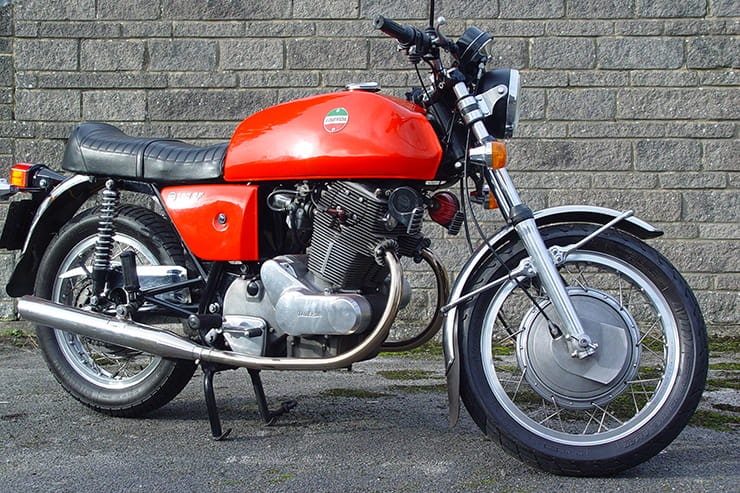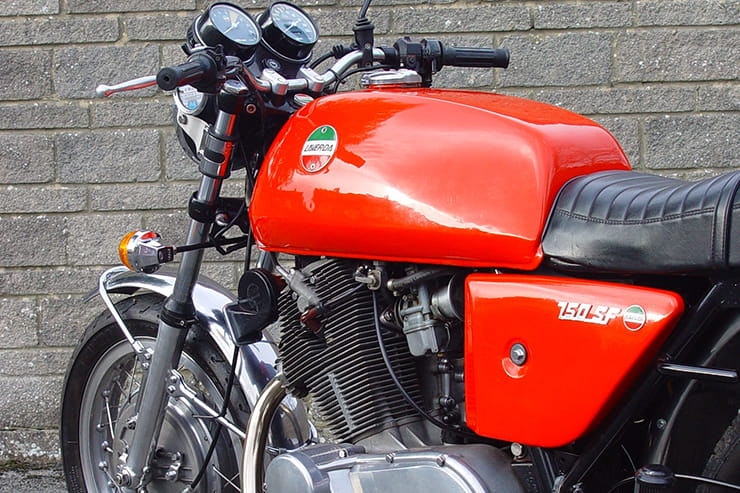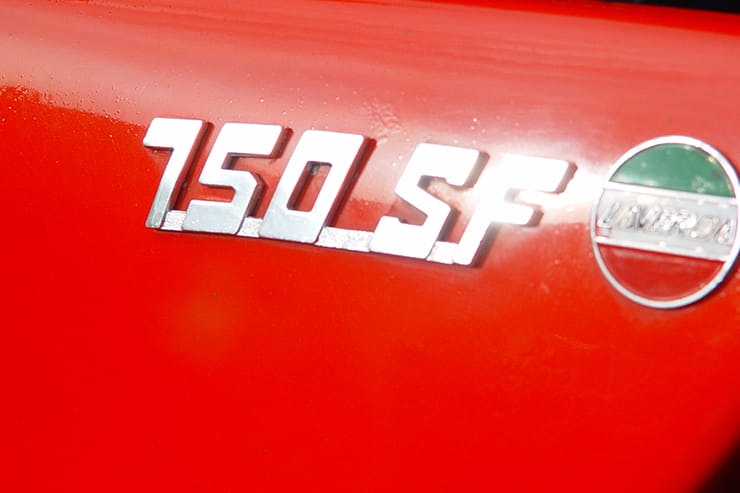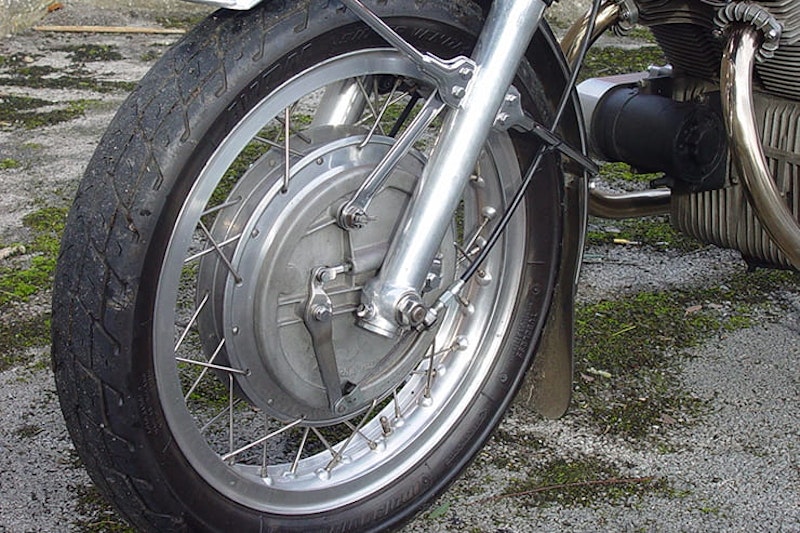Laverda 750 SF (1971) – Classic Review
By Rowena Hoseason
Rowena has been writing about dubious motorcycles since she was 17; somehow survived achieving terminal velocity on her Kawasaki GPz750 Turbo, and keeps claiming to be taking life easier these days with old clunkers. Current wheels include a BMW G310R and a Triumph Hurricane X-75 (which just proves that she tells fibs, too)
19.11.2019
Some classic bikes are best suited to polishing and pimping, rather than high-speed rides. They’re all show and not much go. This accomplished Italian sportster is exactly the opposite…
Not all classic Laverdas are Jotas. They’re not all triples either…or orange…or need a month at the gym simply to operate the clutch. This one’s a red 750 twin with a clutch that doesn’t require the grip of a gorilla. Outrageous, eh?
Back in the mid-1960s, the Italian manufacturer decided they needed a two-cylindered 650 to sell to the American market. The new Laverda parallel twin was inspired by aspects of Honda’s CB77 and was intended to be modern, nimble and near as dammit indestructible, combining Japanese standards of build quality with British equipment – Massimo Laverda was a big fan of the British industry and its products.
The 650 was unveiled in 1966 and the first production models rolled onto the road in 1968. It was soon joined by a 744cc version in Gran Tourismo trim. A year later the Sport version joined the line-up, running higher compression and offering an additional 8bhp over the GT. All three models were popular although they weren’t without flaws. Many commentators didn’t like the Honda style of the engine (‘If I wanted a CB72 then I wouldn’t buy a Laverda’), and the complicated Grimeca front brake came in for severe criticism.
When the S and GT models morphed into a new machine, the brake was therefore very important. So important that it became the name of the machine – SF stands for Super Freni, meaning ‘super brake’. They weren’t kidding; it was good enough to be used on the firm’s endurance racers and on the first of the triples. This new super stopper was designed by Dr Francesco Laverda himself, while the rest of the bike was laid out by Luciano Zen’s engineering team, based around the rock-solid foundations of the first 650 and 750s.
SF stands for ‘Super Freni’, meaning ‘Super Brake’
The result was a cracking combination of speed, style and accessible power which made the SF one of the best vertical twins ever built - a machine capable of holding its own against the early UJMs. For Laverda enthusiasts, the first version with Smiths clocks and Bosch headlamp which arrived at the advent of the 1970s is the best of the SFs. It kept the earlier heavy flywheel from earlier 750s and matched small-bore Dell’Orto carbs to a free-breathing exhaust.
For 1971 the name remained the same but there were several developments, including Japanese NipponDenso instruments instead of Smiths clocks. When buying, bear in mind the time lag between Laverda launching a new model in Italy and actual bikes being imported and registered in the UK; model years and registrations dates often don’t quite match.
For 1972 the SF1 arrived with a different character, beefed up crank, bigger pumper carbs, new silencers, lower compression and slightly more power. The SF2 in 1974 came with a single 280mm Brembo disc front brake – twin discs were soon introduced for the front, but you’ll find bikes with either set-up. The dual saddle also became standard fitment.
The last hurrah of the SF arrived in 1976. The SF3 sported 5-spoke cast alloy wheels, a duck-tail seat, a rear disc brake, and its gear and brake levers swapped sides. Over time, Laverda lightened the flywheels to improve acceleration so the engine’s characteristics do change from SF to SF3. The final incarnation was no faster, flat out, than the first.
For its time, the 750 SF was bang up to date. Its oil-tight, twin-carb, electric start, five-speed ohc engine ticked every box at the start of the 1970s. That’s why the SF variants proved to be Laverda’s most successful model range, notching up over 18,000 sales. Yet today, most people still think ‘Jota’ whenever anyone mentions Laverda. Go figure.
Price
SFs can be picked up from £5500, for a model that will be running but needs attention, to around £8500 for an immaculate model. As with all classics, we would advise buying the best you can afford. For more tips on buying classics, see our guide here
A parallel twin that doesn’t vibrate (much) was built to last and made good power too
Power and torque
By modern standards, the SF’s power output ain’t too shabby. You get 60bhp at 6600rpm – compared to around 55 horsepower at 6250rpm from Honda’s current fuel-injected, liquid-cooled 8-valve NC750 twin.
The SF also proves that it ain’t what you got that matters, it’s the way that you use it. In 1972, one roadtester took a 750 from Land’s End to John O’Groats in less than 16 hours. On A-roads. That’s around a thousand miles. Giving an average speed – including stops – of 64mph. This is a very fast, very capable classic.
Some roadtesters reckoned the SF would pull at 1600rpm in top, which is a teeny bit optimistic, but it’ll cope with 2000rpm in fifth gear. On the open road it starts singing at 5000rpm, really pulls strongly at 6k and fairly flies at 7500rpm. This is one classic which you can push right to the redline and beyond.
A decent SF will go from 0 to 60mph in around six seconds, cruise all day at 75mph, and top out at 115mph. It’s genuinely fast enough to keep up with modern traffic.
Engine, gearbox and exhaust
This twin-cylinder sohc powerplant was built to last and to disprove the notion that all parallel twins inevitably leak. It succeeded: plenty of examples have now clocked up over 100,000 miles. The all-alloy motor is usually described as ‘over-engineered’ or ‘unburstable’; it was split horizontally with four meaty bearings supporting the crank while the chunky conrods were cushioned by a double row of roller bearings.
Laverda used a triplex chain to carry the primary drive, a duplex camchain and a simplex chain for the electric starter. The camchain came complete with a spilt link to make replacement less of a chore than an entire engine strip. The dynamo drive lived on the far right of the crankshaft, while the gear-type oil pump was driven from the left side along with the contact-breaker ignition. This all made it a wide old engine with expensive components living in risky real estate; a good argument for crash bars if ever there was one.
The seven-plate clutch ran in an oil bath and fed power to a five-speed box, from where it travelled by chain to do the business at the back wheel. The clutch was ‘tough’ when the bike was new and over time it can get worse. Aging SFs can also suffer from dreadful low-rev running, vicious braking, stiff controls, bad vibes, notchy gearbox, harsh ride, corroding chrome, impractical gearing, transmission snatch from the primary drive, poorly-adjustable footrests, wet weather misfires and white-line wobbles on worn tyres.
Seek out a bike with an expert owner who has fitted a modern electronic ignition, set up the carbs correctly and lubed all the cables. If an SF feels especially buzzy then the carbs may be out of synch or an engine bolt might be wriggling loose – the engine under load should feel gruff but smooth. Stand behind the bike when it’s running and check the pressure of gases coming from each pipe – if one pipe is obviously pushing out much more gas than the other then it definitely needs fettling.
Free-flowing exhausts sound as good as you’d hope
Economy
On relaxed classic clubland rides you’ll get as much as 60mpg, but that drops radically at speeds over 70mph. On a rapid thrash, mid-30s are entirely possible.
Handling, suspension, chassis and weight
On paper, the original SF is heavy at 480lb dry with a long wheelbase and a lot of trail which, should make it fall into corners (unlike the long, three-cylinder Laverdas which take some wrestling around tight turns). In practice, the 750 feels little bigger than a 500, with neutral, predictable steering and no nasty habit of tucking in when you unadvisedly shut the throttle mid-corner (don’t make a habit of that, btw).
The SF series have a well-deserved reputation for a certain stiffness in the chassis dept. Robust, dual tubes connect the headstock and swinging arm, while the monstrously solid motor forms part of the frame. The original Ceriani suspension was famously firm even on its softest setting. This gave the Laverda a genuine edge over its Japanese rivals, where the engines easily overwhelmed the chassis’ capabilities. A decent SF can outpace a more powerful 1970s Japanese four-cylinder machine on the road, but it does demand significant rider input to extract maximum performance from its potential. There’s an immediacy and involvement to riding the SF; it puts you in direct contact with the road and the beat of the beast itself. You feel every quiver and thrum from its innards or, as old roadtests like to say, ‘some vibration is apparent.’
Sharp handling chassis, but you have to work at it to get the best of what the SF3 can give
Brakes
The beefy 230mm front drum brake was a bit of a monster back in its day and when set up properly it provides powerful, predictable deceleration. It can also be grabby, which ain’t great in the wet, and depending on the state of the shoes may fade after several sustained applications. Find the right kind of linings and get an expert to set it up, and then the machine will comfortably stop in 30ft from 30mph.
Comfort
Minimal. The SF may not have a radical clip-ons, rearsets and a full race fairing but you should think of it as an uncompromising sportster, not a relaxed roadster. The ride is very firm and the riding position doesn’t suit everyone. Backache and sore wrists can be common and even though it doesn’t vibrate like an old Brit twin, you will feel the vibes at high revs through the bars and pegs.
Early bikes had Smiths clocks, later ones like this had the Japanese NipponDenso units
Equipment
Even when it was new, the SF was let down by variable fit and finish. Many of its bought-in components (switchgear, prop stand, foot controls, etc) seemed to come out of the bargain bin and weren’t appropriate for a high-end machine with a hefty price tag. The original items haven’t got any better with time, so make sure you look for an example which has been owned by a dedicated enthusiast – likely to upgrade and improve the OE spec – and not Johnny Bodger who’ll have compounded all the issues.
Laverdas are famous for tough clutches for a reason. The featured bike was modified with a Todd clutch conversion (there are several types available these days); a huge improvement and a must-have upgrade if you ride around town.
A good SF will fire up reliably on the button – not something you can say about many classic twins. The lack of a kickstart raised some eyebrows in 1970-something, but the SF is equipped with a 1hp starter motor and a battery as big as a barn. The only problem with that big battery is that a replacement can set you back 60 quid.
Classic considerations
Slater Laverda are still the first stop for spares, although many components can also be sourced from Italy via eBay. Reproduction basic manual and parts books are stocked at the National Motorcycle museum shop, but seek out an original Clymer manual for in-depth instructions (or learn to read Italian).
Basic maintenance should be well within the scope of most home mechanics, and experienced owners can tackle jobs like camchain replacement without removing the engine from the frame. Help can always be sought from the International Laverda Owner's Club
Engine parts are in good supply, but bodywork is harder to find.
Laverda styling heritage present and correct
1971 Laverda 750 SF verdict
A real rider’s classic. It demands commitment from its owner to keep it well fettled, and from its rider to extract maximum performance from its undoubted potential. Not a classic for a newbie, nor for back-lane ambling.
Three things I loved about the Laverda 750 SF…
• Relentless appetite for high mileage at high speed
• Sturdy engineering
• Superb steering
Three things that I didn’t…
• Harsh ride
• Heavy controls
• Dodgy ancillaries
1971 Laverda 750 SF spec
Looking for bike insurance? Get a quote for this motorcycle withBennetts motorbike insurance



